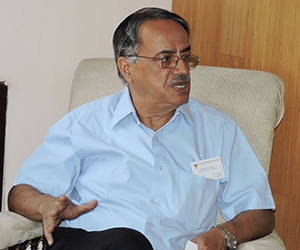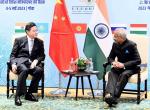The year 2015 is expected to be a turning point in the evolving strategic and economic relationship between the United States and Vietnam. While assertive behaviour of China in South China Sea can said to be one of the motivations behind US and Vietnam coming closer, there are other very valid reasons and logic for both to forge stronger ties.
This is despite the fact that the US and Vietnam fought a war not very long ago when Vietnamese forces drove out the Americans from their country in 1975. Diplomatic relations were established between the two in 1995 due to changing strategic environment and converging interests. The relationship gained further momentum in 2013 when both sides announced a comprehensive partnership for moving their ties to a new level. Moreover, Vietnam is one of the few ASEAN countries that is participating in the US initiated Trans Pacific Partnership (TPP) free trade agreement negotiations. TPP is considered as the economic pillar of America’s ‘rebalance to Asia’ strategy.
Last year in May a bilateral civil nuclear energy cooperation agreement was signed which reflected greatly the confidence reposed by the US in a Communist country that is now on the reform path. Of course, American companies stand to greatly benefit from the construction of nuclear reactors in Vietnam. Also, Hanoi agreed to join the US sponsored Proliferation Security Initiative which it had earlier refused to join as the same is not part of the UN System.
In May 2014 tensions between Vietnam and China rose because the state-owned China National Offshore Oil Corporation (CNOOC) moved a large exploratory oil rig HD-981 to area within Vietnam’s Exclusive Economic Zone, although China also lays claim to the area. However, the US State Department stressed that the oil rig should withdraw as positioning the rig was tantamount to change of status quo. Similarly, the US along with Vietnam, Philippines and some other countries has objected to China’s reclamation activities in Spratly Islands which have accelerated in the past few months.
Trade between US and Vietnam in 2014 was 34 billion dollar a massive jump from about 220 million USD in 1994. Vietnam has in fact become the second largest source of US imports of clothing and some other household accessories. Vietnam’s exports to the US have exceeded those to the EU in 2014 thus making the US the top export market. Shift to a market oriented economic system in the late eighties and thereafter a sustained economic growth has enabled Vietnam to achieve a trade surplus with the US which stood at around 19 billion US dollars in 2013 and is expected to be around 20 billion dollars for 2014.
Further, in terms of ease of doing business rankings released by the World Bank, Vietnam is ahead countries like China, Brazil and India. No surprise therefore, that Vietnam has become an attractive destination for American investments.
The frequency of high level political changes actually increased since President Bill Clinton’s visited Vietnam in the year 2000, a first by any American President. Vietnam’s Prime Minister Phan Van visited the US in June 2005; thereafter political and diplomatic exchanges have been on the upward trajectory. But what is going to mark the beginning of a new phase of bilateral relationship is the forthcoming visit of the Vietnam’s Communist Party Secretary General Nguyen Phu Trong to the US in July. This would be first such visit by the top Communist Party leader of Vietnam to the US indicating the distance both countries have travelled over the years to forge a mutually beneficially relationship despite differing political systems.
While moving closer to Washington, Vietnam takes great care in balancing its relationship with China. As a prelude to the forthcoming visit to the US Nguyen Phu Trong visited Beijing in April to mend its souring relationship with China arising out of the South China Sea imbroglio. Beijing is also concerned with Vietnam moving closer to America and becoming part of its strategic design in Asia-Pacific. Though party to party relationship between China and Vietnam is considered to be on an even keel Beijing appears to be unwilling to let go of what it calls its ‘core interests’ in South China Sea.
Meanwhile, the US has been openly denouncing China’s approach to the vexed issue of South China Sea. During the recent Shangri La Dialogue held towards the end of May in Singapore, the United States Secretary of Defence, Ashton Carter emphasised that “The United States is deeply concerned about the pace and scope of land reclamation in the South China Sea, the prospect of further militarisation, as well as the potential for these activities to increase the risk of miscalculation or conflict among claimant states”. Calling for a halt of such reclamation activities he added that the US will conduct surveillance flights over South China Sea and continue to protect the right of freedom of navigation and overflight. He also favoured an early conclusion of Code of Conduct by China with the ASEAN.
After the Shangri La Dialogue, Ashton Carter visited Vietnam to strengthen defence ties and military-to-military relationship. As a first step, the US has agreed to provide 18 million dollars to Hanoi for acquisition of patrol boats for the Coast Guard for enhancing its maritime security. Cooperation in defence and security is likely to be further upgraded with lifting of embargo on export of lethal arms. Republican Senator John McCain, Chairman of the Armed Services Committee has recommended sale of lethal arms to Vietnam though some concerns still exist regarding this in the US.
Overall, the US-Vietnam relationship is poised to enter a new era This is also the year when both countries are celebrating the 20th anniversary of the normalization of bilateral ties which is in direct contrast to what happened four decades earlier. As a reciprocal gesture, President Obama may also visit Vietnam soon, thus taking the relationship to a new high.
In so far as Indian perspective is concerned, New Delhi been supporting freedom of navigation, adherence to UNCLOS and adoption of a Code of Conduct by all parties in South China Sea. This supports the stand taken by both US and Vietnam. Strengthening of US-Vietnam relations and India’s support is expected to contribute to strategic equilibrium in the region.
Published Date: 13th June 2015, Image Source: http://www.gmanetwork.com










Post new comment